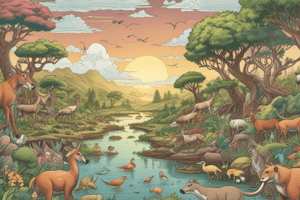Podcast
Questions and Answers
What is the difference between a food web and a food chain?
What is the difference between a food web and a food chain?
Food webs show how plants and animals are connected in many ways to help them survive, while food chains follow just one path as animals find food.
What powers all food chains and webs?
What powers all food chains and webs?
The sun's energy.
Where do animals get the energy they need and why do they need the energy?
Where do animals get the energy they need and why do they need the energy?
Animals get energy from the food they eat in order to move and grow.
How is a food chain developed?
How is a food chain developed?
Why are plants called producers?
Why are plants called producers?
What is a consumer?
What is a consumer?
What is a herbivore?
What is a herbivore?
What is a carnivore?
What is a carnivore?
What is a secondary consumer?
What is a secondary consumer?
What is a tertiary consumer?
What is a tertiary consumer?
What is an omnivore?
What is an omnivore?
What is a decomposer?
What is a decomposer?
What happens in a food chain?
What happens in a food chain?
What happens to the amount of energy?
What happens to the amount of energy?
What happens to the amount of energy in a food chain?
What happens to the amount of energy in a food chain?
What happens to the amount of consumers in a food chain?
What happens to the amount of consumers in a food chain?
How many links are in a food chain?
How many links are in a food chain?
Why can't there be too many links in a food chain?
Why can't there be too many links in a food chain?
What makes a food web?
What makes a food web?
What can you substitute the arrows in a food chain or web by?
What can you substitute the arrows in a food chain or web by?
Flashcards are hidden until you start studying
Study Notes
Food Chains vs. Food Webs
- Food webs illustrate the complex interconnectedness among plants and animals, while food chains depict a single linear pathway of energy transfer.
- All food webs and chains are fundamentally powered by the sun's energy.
Energy in Food Chains
- Living organisms acquire energy from the food they consume, which is essential for movement, growth, and overall survival.
- Energy is released during the digestion process as food passes through the body.
Structure of Food Chains
- Food chains initiate with plant life (producers) and conclude with an animal (consumer).
- Plants are termed producers due to their ability to convert sunlight into food (sugar) using carbon dioxide and water.
Types of Consumers
- Consumers are organisms that lack the ability to create their own food and thus rely on eating plants and/or other animals.
- Herbivores are primary consumers that solely consume plants.
- Carnivores are consumers that exclusively eat other animals, divided into secondary consumers (eat herbivores) and tertiary consumers (eat other carnivores).
- Omnivores consume both plants and animals, demonstrating dietary flexibility.
Decomposers and Energy Transfer
- Decomposers, such as bacteria and fungi, play a vital role by feeding on decaying organic matter.
- In food chains, energy is transferred from one organism to the next; however, energy diminishes at each successive link due to loss at each trophic level.
- The overall energy and food availability decrease as one moves up the food chain.
Characteristics of Food Chains
- Food chains are typically limited to four or five links to ensure sufficient energy remains for all organisms involved.
- A limited number of links prevents overextension, which would leave higher-level consumers with inadequate food resources.
Composition of Food Webs
- Food webs consist of multiple interconnected food chains, allowing organisms to have varied diets and meet their energy needs effectively.
- Arrows in food chains and webs can be substituted with the phrase “eaten by” to represent the direction of energy flow.
Studying That Suits You
Use AI to generate personalized quizzes and flashcards to suit your learning preferences.



